FSK/ASK Orthogonal Modulation System Based on Novel Noncoherent Detection and Electronic Dispersion Compensation for Short-Reach Optical Communications
Abstract
:1. Introduction
2. Operating Principle
3. Numerical Simulation Setup and Results
3.1. 2FSK/2ASK Orthogonal Modulation Format
3.2. 2FSK/4ASK Orthogonal Modulation Format
4. Conclusions
Supplementary Materials
Author Contributions
Funding
Institutional Review Board Statement
Informed Consent Statement
Data Availability Statement
Conflicts of Interest
References
- Kikuchi, K. Fundamentals of coherent optical fiber communications. J. Lightw. Technol. 2016, 34, 157–179. [Google Scholar] [CrossRef]
- D’Ambrosia, J. IEEE P802.3bs Baseline Summary. 2015. Available online: http://www.ieee802.org/3/bs/ (accessed on 15 January 2018).
- Rizzelli, G.; Nespola, A.; Straullu, S.; Forghieri, F.; Gaudino, R. Two-Fiber Self-Homodyne Transmission for Short-Reach Coherent Optical Communications. In Proceedings of the 22nd International Conference on Transparent Optical Networks (ICTON), Bari, Italy, 19–23 July 2020. [Google Scholar]
- Seimetz, M.; Noelle, M.; Patzak, E. Optical systems with high-order DPSK and star QAM modulation based on interferometric direct detection. J. Lightw. Technol. 2007, 25, 1515–1530. [Google Scholar] [CrossRef]
- Che, D.; Hu, Q.; Shieh, W. High-spectral-efficiency Optical Direct Detection Using the Stokes Vector Receiver. In Proceedings of the European Conference on Optical Communication (ECOC), Valencia, Spain, 27 September–1 October 2015. [Google Scholar]
- Zhang, L.; Zuo, T.; Mao, Y.; Zhang, Q.; Zhou, E.; Liu, G.N.; Xu, X. Beyond 100-Gb/s transmission over 80-km SMF using direct-detection SSB-DMT at C-Band. J. Lightw. Technol. 2016, 34, 723–729. [Google Scholar] [CrossRef]
- He, Z.; Tao, Z.; Hu, F.; Chi, N.; Huang, D. 40 Gb/s CSRZFSK signal generation and transmission labeled with ASK in optical packet networks. Optik 2013, 124, 529–532. [Google Scholar] [CrossRef]
- Liu, Y.; Fengguang, L. Realization of FSK/ASK modulation format based on a dual-parallel modulator. Opt. Quant. Electron. 2017, 8, 260. [Google Scholar]
- Zhou, R.; Xin, X.; Zhang, Q.; Zhao, K.; Zhao, T.; Yu, C. Study of FSK/IM orthogonal modulation system with optical Manchester-coded payload. Chin. Opt. Lett. 2010, 8, 464–467. [Google Scholar] [CrossRef]
- Petermann, K. Laser Diode Modulation and Noise; Kluwer Academic Publishers: Dordrecht, NL, USA, 1991. [Google Scholar]
- Slavik, R.; Park, Y.; Kulishov, M.; Morandotti, R.; Azaña, J. Ultrafast all-optical differentiators. Opt. Express 2006, 14, 10699–10707. [Google Scholar] [CrossRef]
- Kumar, S.; Deen, M.J. Fiber Optic Communications: Fundamentals and Applications; John Wiley & Sons: Chichester, UK, 2014. [Google Scholar]
- Kawanishi, T.; Sakamoto, T.; Miyazaki, T.; Izutsu, M. High-speed optical DQPSK and FSK modulation using integrated Mach–Zehnder interferometers. Opt. Express 2006, 14, 4469–4478. [Google Scholar] [CrossRef]
- Kawanishi, T.; Higuma, K.; Fujita, T.; Ichikawa, J.; Sakamoto, T.; Shinada, S.; Izutsu, M. High-speed optical FSK modulator for optical packet labeling. J. Lightw. Technol. 2005, 23, 87–94. [Google Scholar]
- Deng, N.; Yang, Y.; Chan, C.-K.; Hung, W.; Chen, L.-K. Intensity modulated labeling and all-optical label swapping on angle modulated optical packets. IEEE Photonics Technol. Lett. 2004, 16, 1218–1230. [Google Scholar] [CrossRef]
- Yu, Y.; Mulvihill, G.; O’Duill, S.; O’Dowd, R. Performance implications of wideband lasers for FSK modulation labeling scheme. IEEE Photonics Technol. Lett. 2004, 16, 39–41. [Google Scholar]
- Li, X. Optoelectronic Devices: Design, Modeling, and Simulation; Cambridge University Press: Cambridge, UK, 2009. [Google Scholar]
- Xin, L.; Zhao, J.; Li, X. Suppression of mode partition noise in FP Laser by frequency modulation non-coherent detection. IEEE Photon. J. 2022, 14, 7201310. [Google Scholar] [CrossRef]
- Zuo, C.; Li, X. Polarization-Discriminated RSOA–EAM for Colorless Transmitter in WDM–PON. Appl. Sci. 2020, 10, 9049. [Google Scholar] [CrossRef]
- Agrawal, G.P. Nonlinear Fiber Optics, 3rd ed.; Academic Press: New York, NY, USA, 2001. [Google Scholar]
- Sinkin, O.V.; Holzlohner, R.; Zweck, J.; Menyuk, C.R. Optimization of the split-step Fourier method in modeling optical fiber communication systems. J. Light Technol. 2003, 1, 61–68. [Google Scholar] [CrossRef]
- Hardin, R.H.; Tappert, F.D. Applications of the split step fourier method to the numerical solution of nonlinear and variable coefficient wave equations. SIAM Rev. Chron. 1973, 15, 423. [Google Scholar]
- Agrawal, G.P. Fiber Optic Communications Systems, 4th ed.; John Wiley & Sons: New York, NY, USA, 2010. [Google Scholar]
- Azaña, J.; Kulishov, M. All-fibre ultrafast optical differentiator based on π phase-shifted long-period grating. Electron. Lett. 2005, 41, 1368–1369. [Google Scholar] [CrossRef]
- Kulishov, M.; Azaña, J. Long-period fiber gratings as ultrafast optical differentiators. Opt. Lett. 2005, 30, 2700–2702. [Google Scholar] [CrossRef]
- Slavik, R.; Park, Y.; Kulishov, M.; Azaña, J. Terahertz-bandwidth high-order temporal differentiators based on phase-shifted long-period fiber gratings. Opt. Lett. 2009, 34, 3116–3118. [Google Scholar] [CrossRef]
- Berger, N.K.; Levit, B.; Fischer, B.; Kulishov, M.; Plant, D.V.; Azaña, J. Temporal differentiation of optical signals using a phase-shifted fiber Bragg grating. Opt. Express 2007, 15, 371–381. [Google Scholar] [CrossRef]
- Kulishov, M.; Azaña, J. Design of high-order all-optical temporal differentiators based on multiple-phase-shifted fiber Bragg gratings. Opt. Express 2007, 15, 6152–6166. [Google Scholar] [CrossRef]
- Park, Y.; Azaña, J.; Slavik, R. Ultrafast all-optical first- and higher-order differentiators based on interferometers. Opt. Lett. 2007, 32, 710–712. [Google Scholar] [CrossRef] [PubMed]
- Dong, J.; Zheng, A.; Gao, D.; Lei, L.; Huang, D.; Zhang, X. Compact, flexible and versatile photonic differentiator using silicon Mach-Zehnder interferometers. Opt. Express 2013, 21, 7014–7024. [Google Scholar] [CrossRef] [PubMed]
- Liu, F.; Wang, T.; Qiang, L.; Ye, T.; Zhang, Z.; Qiu, M.; Su, Y. Compact optical temporal differentiator based on silicon microring resonator. Opt. Express 2008, 16, 15880–15886. [Google Scholar] [CrossRef] [PubMed]
- Dong, J.; Zheng, A.; Gao, D.; Liao, S.; Lei, L.; Huang, D.; Zhang, X. High-order photonic differentiator employing on-chip cascaded microring resonators. Opt. Lett. 2013, 38, 628–630. [Google Scholar] [CrossRef] [PubMed]
- Li, M.; Jeong, H.-S.; Azaña, J.; Ahn, T.J. 25-terahertz-bandwidth all-optical temporal differentiator. Opt. Express 2012, 20, 28273–28280. [Google Scholar] [CrossRef] [PubMed]
- Ahn, T.-J.; Azaña, J. Wavelength-selective directional couplers as ultrafast optical differentiators. Opt. Express 2011, 19, 7625–7632. [Google Scholar] [CrossRef]
- You, H.; Ning, T.; Jian, W.; Pei, L.; Wen, X.; Li, J.; Chen, H. Optical temporal differentiator using a twin-core fiber. Opt. Eng. 2013, 52, 015005. [Google Scholar] [CrossRef]
- ITUT, G. Sup39; Optical System Design and Engineering Considerations. International Telecommunication Union: Geneve, Switzerland, 2016.
- ITUT, G.9807.1; 40-Gigabit-Capable Passive Optical Networks (NG-PON2): General Requirements 10-Gigabit-Capable Symmetric Passive Optical Network (XGS-PON). International Telecommunication Union: Geneve, Switzerland, 2016.
- IEEE 802.3ah; Part 3: Carrier Sense Multiple Access with Collision Detection (CSMA/CD) Access Method and Physical Layer Specifications. Institute of Electrical and Electronics Engineers: New York, NY, USA, 2004.
- Azcoaga, B.; Juan, A. 40 Gb/s Optical Transmission Systems. DTU Library. 2003. Available online: https://backend.orbit.dtu.dk/ws/portalfiles/portal/3013571/headb5.pdf (accessed on 28 October 2003).
- Jones, D.J.; Zhang, L.M.; Carroll, J.E.; Marcenac, D.D. Dynamics of monolithic passively mode-locked semiconductor lasers. IEEE J. Quantum Electron. 1995, 31, 1051–1058. [Google Scholar] [CrossRef]
- Zhao, J.; Shi, K.; Yu, Y.; Barry, L.P. Theoretical analysis of tunable three-section slotted Fabry-Perot lasers based on time-domain traveling wave model. IEEE J. Sel. Top. Quantum Electron. 2013, 19, 1503108. [Google Scholar]
- Park, J.; Li, X.; Huang, W.P. Performance simulation and design optimization of gain-clamped semiconductor optical amplifiers based on distributed Bragg reflectors. IEEE J. Quantum Electron. 2003, 39, 1415–1423. [Google Scholar] [CrossRef]
- Connelly, M.J. Wideband semiconductor optical amplifier steady-state numerical model. IEEE J. Quantum Electron. 2001, 37, 439–447. [Google Scholar] [CrossRef]
- Park, J.; Li, X.; Huang, W.P. Comparative study of mixed frequency-time-domain models of semiconductor laser optical amplifiers. IEE Proc.-Optoelectron. 2005, 152, 151–159. [Google Scholar] [CrossRef]
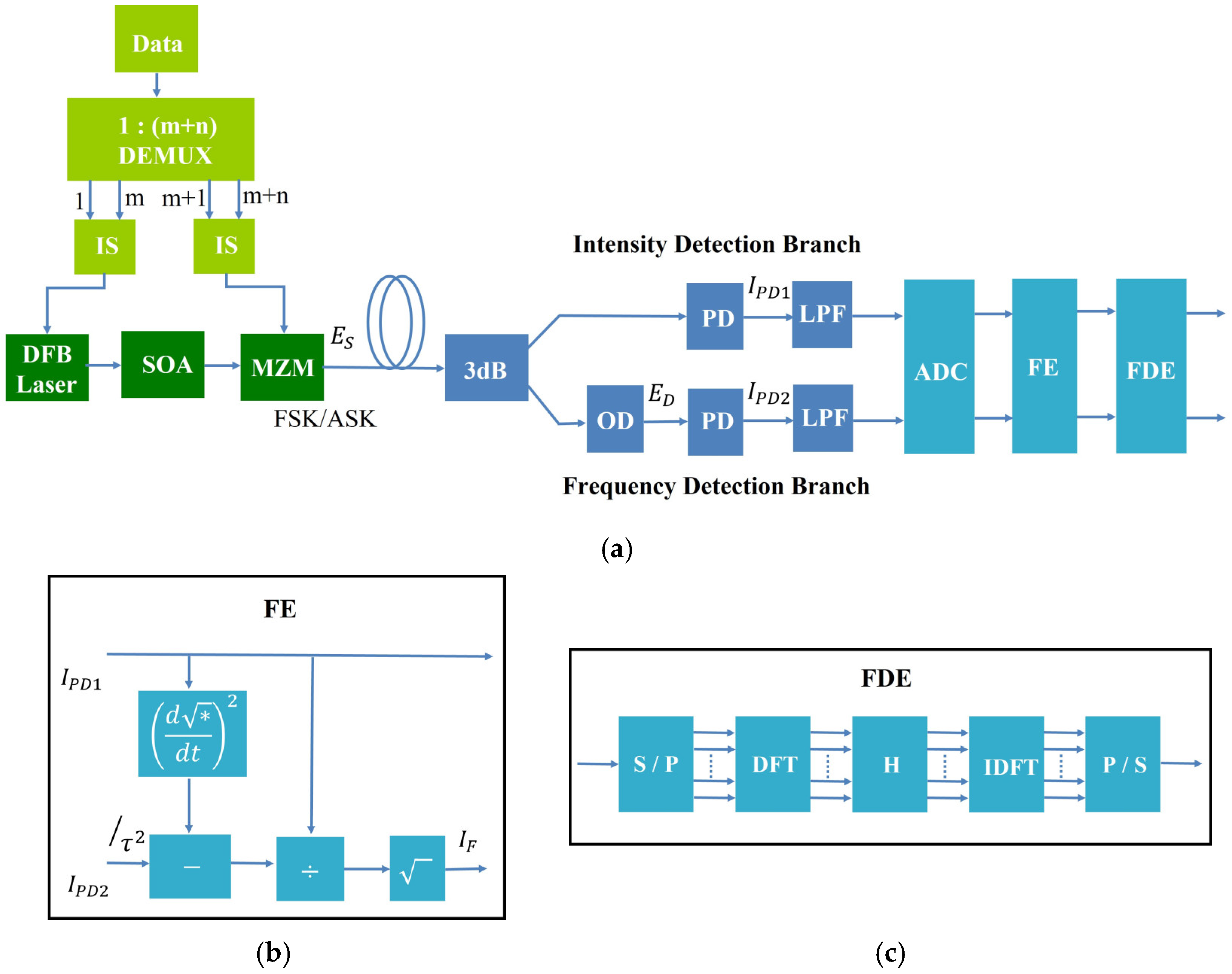

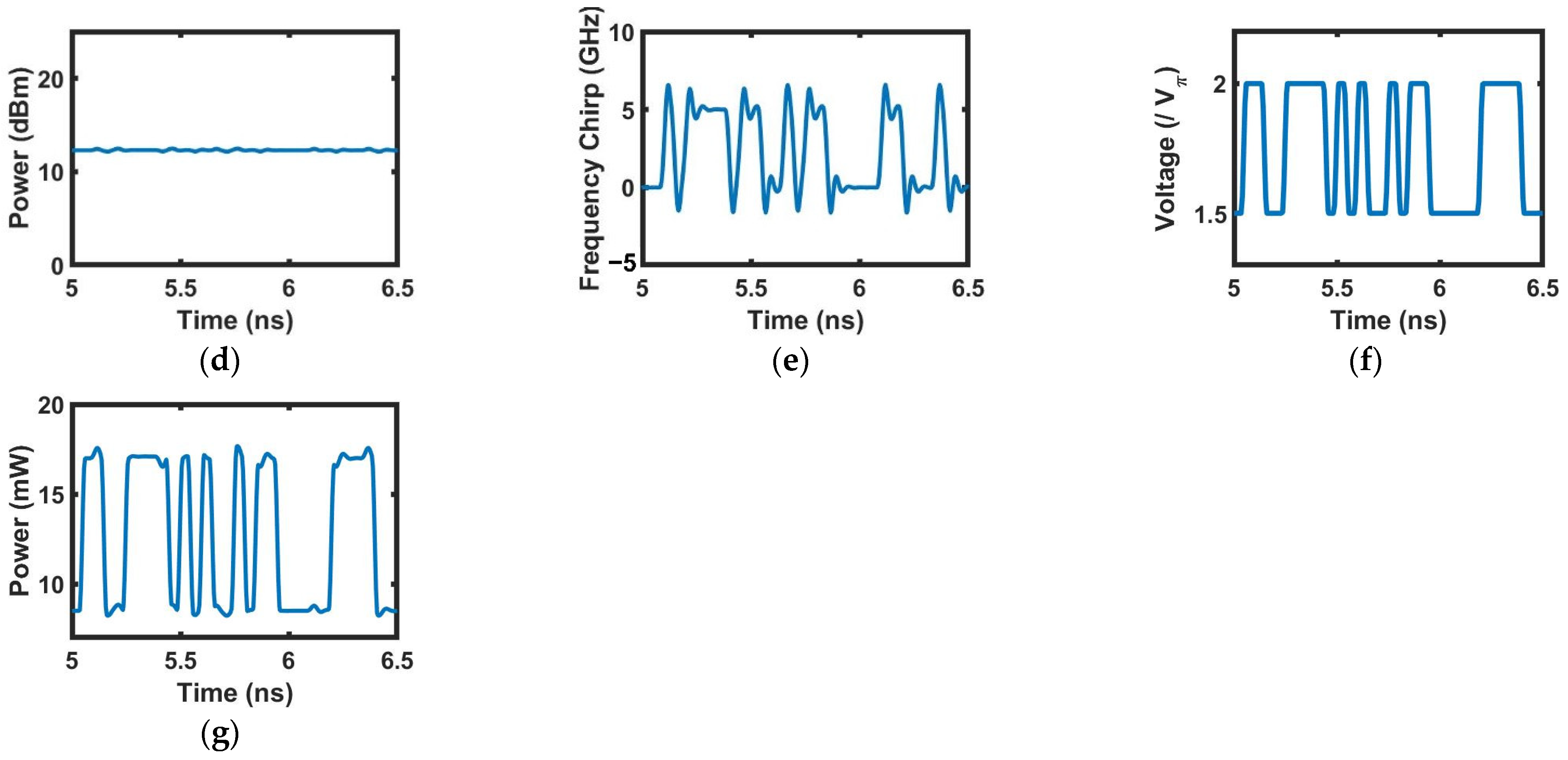
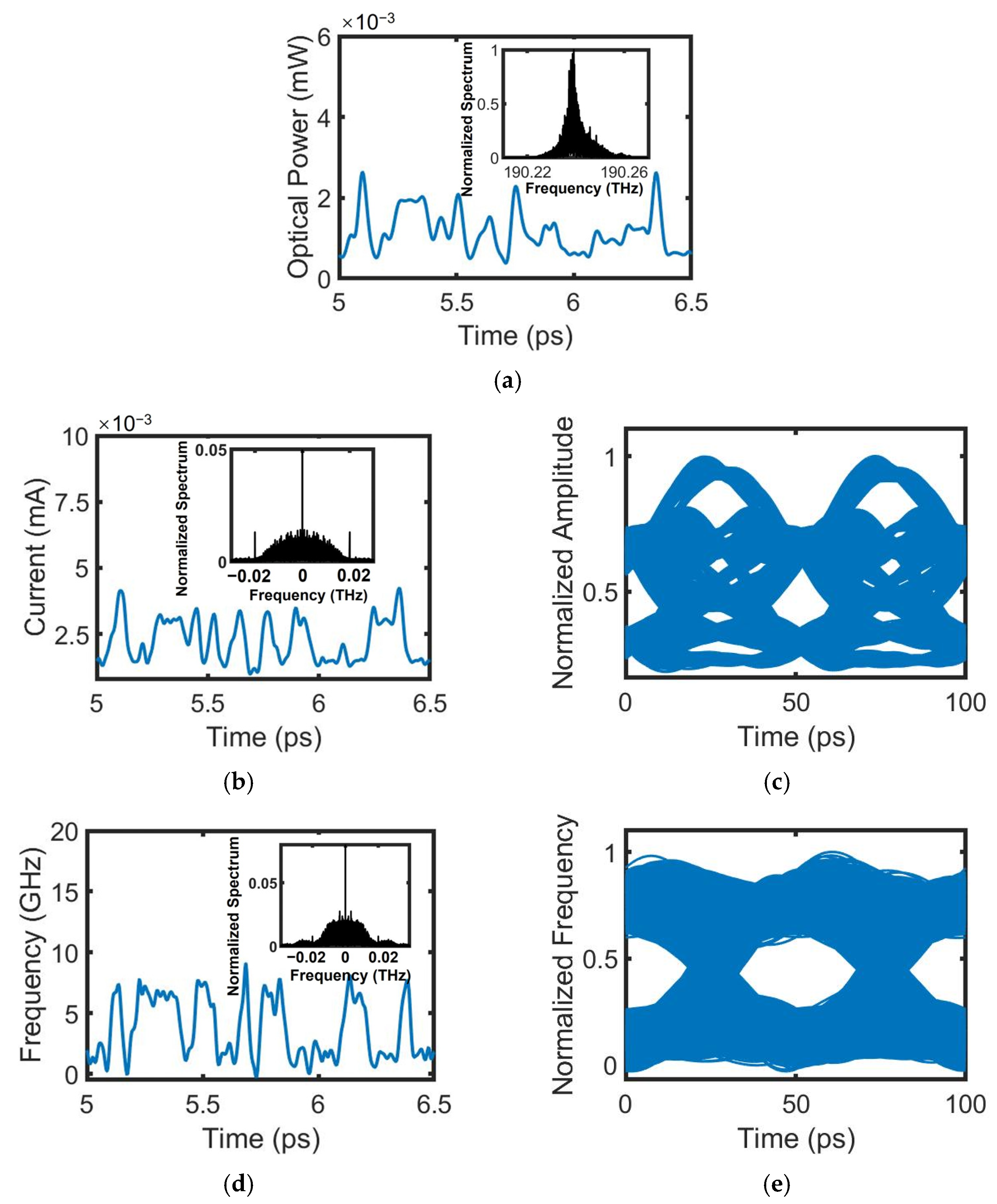
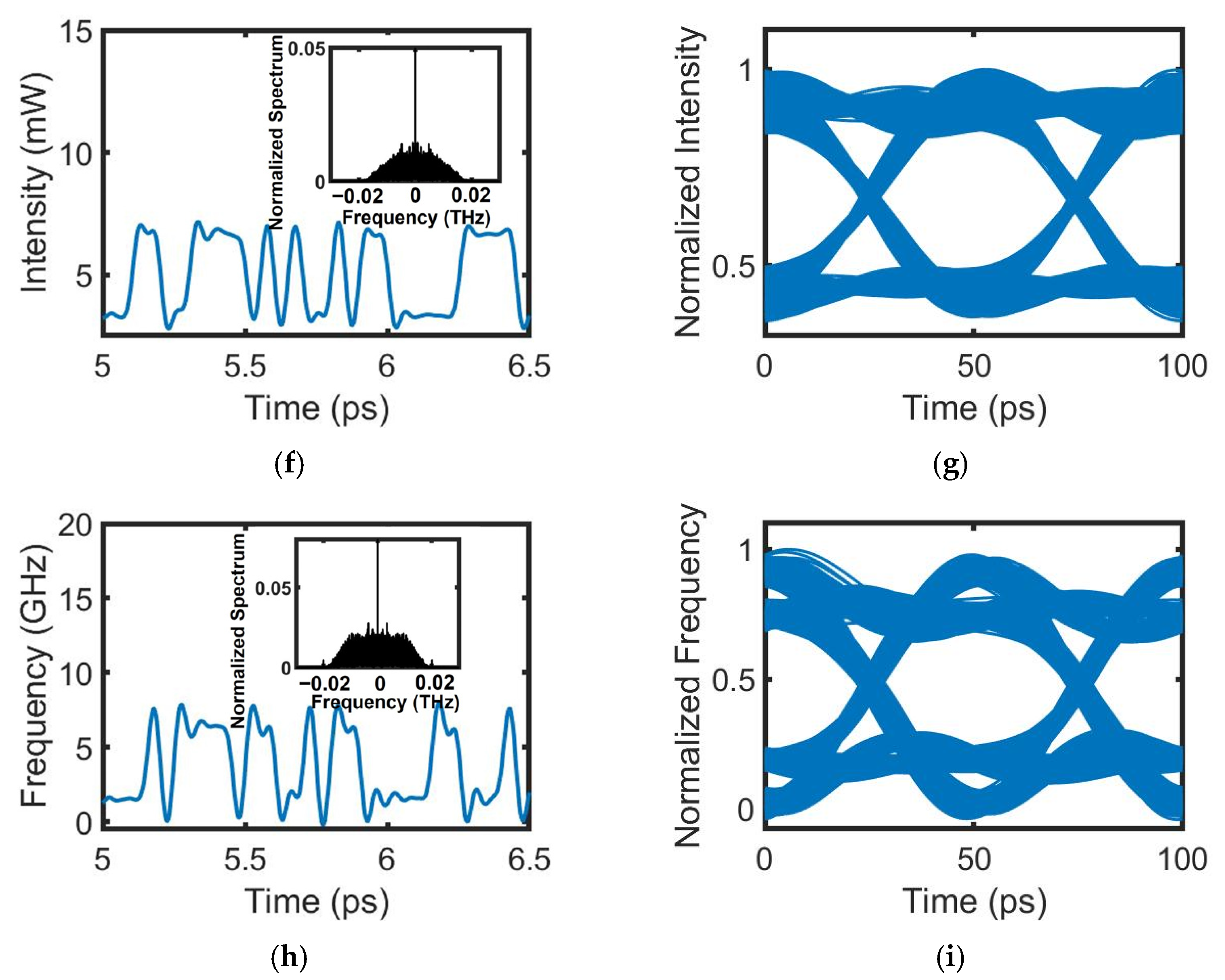
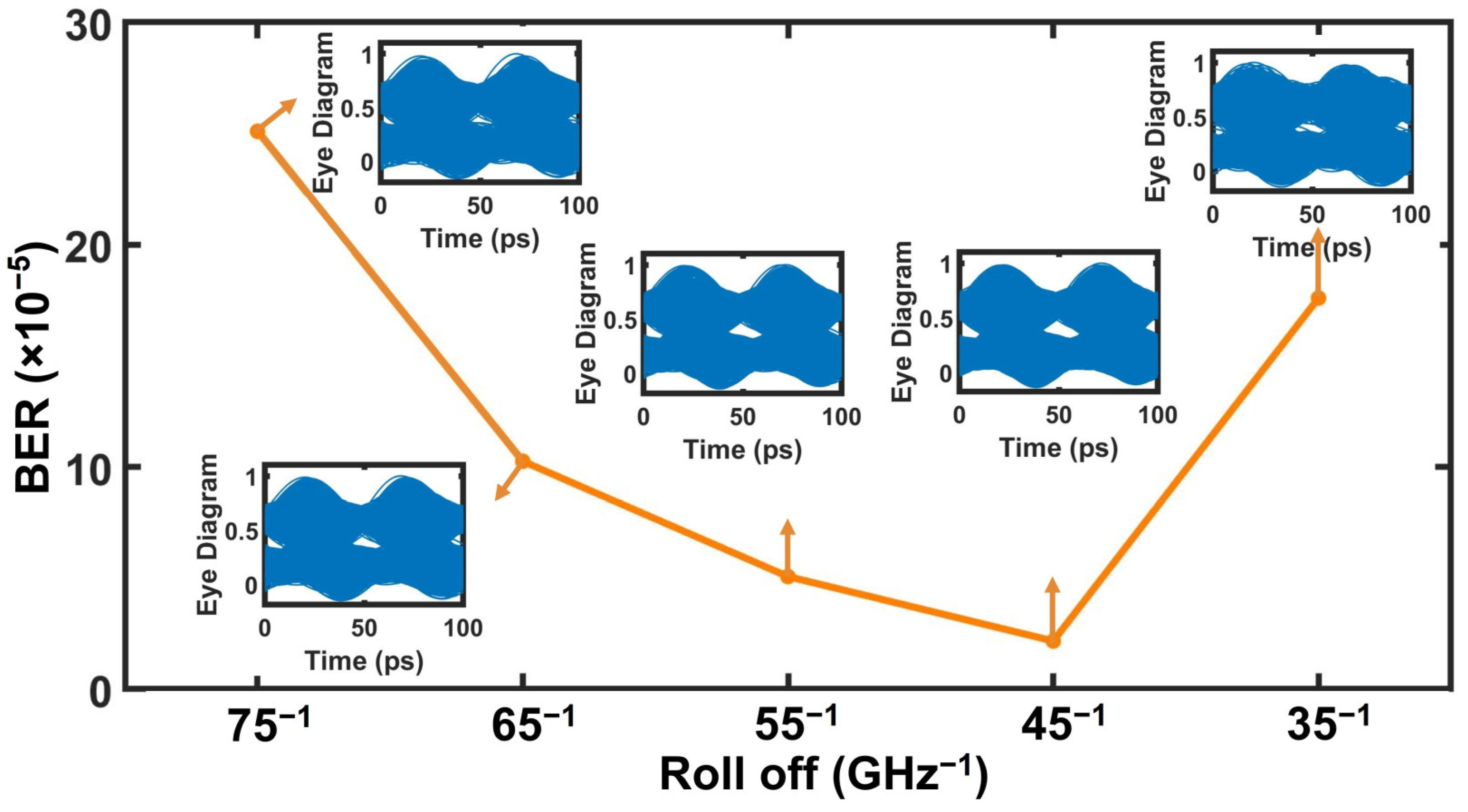
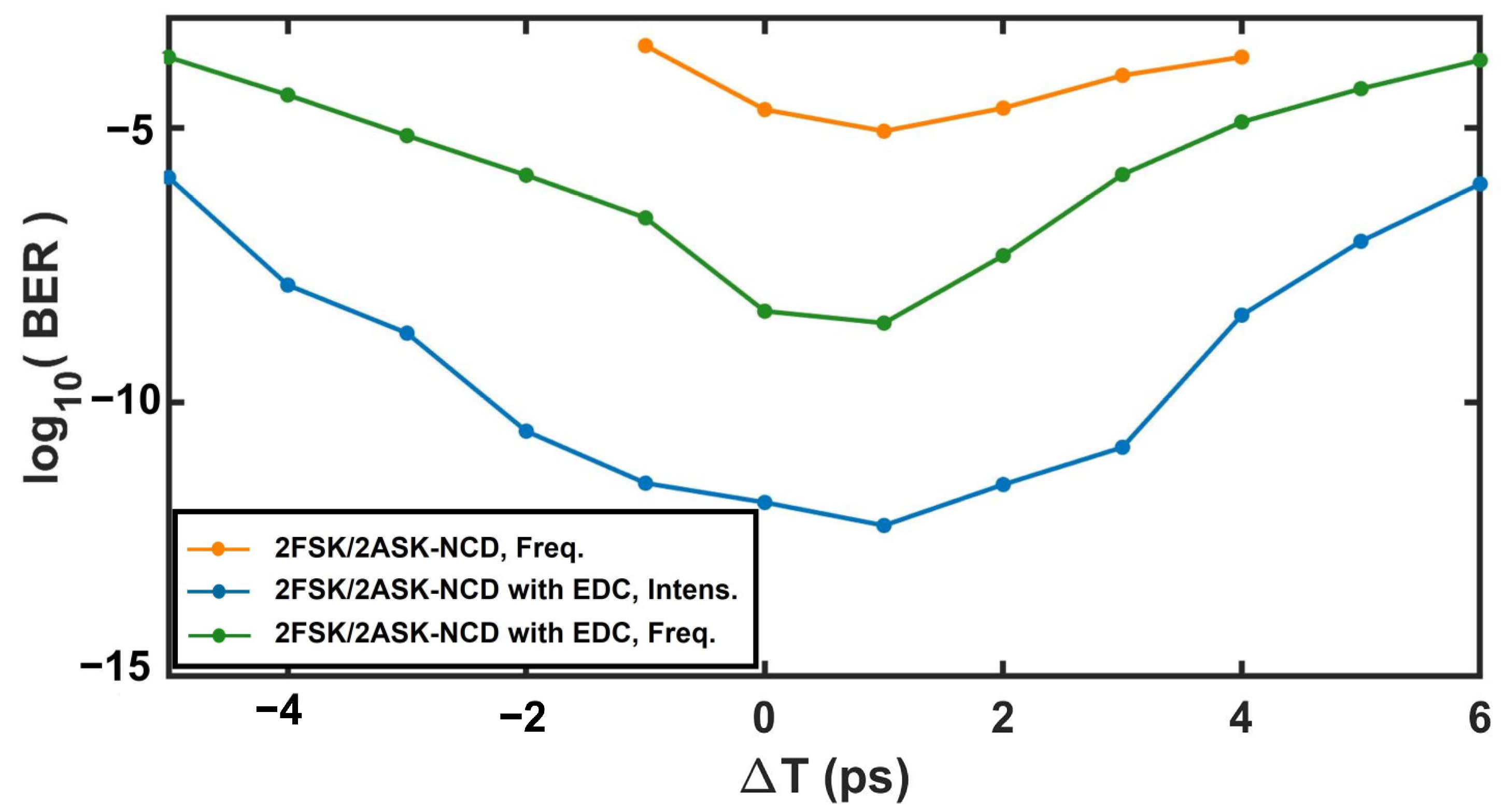
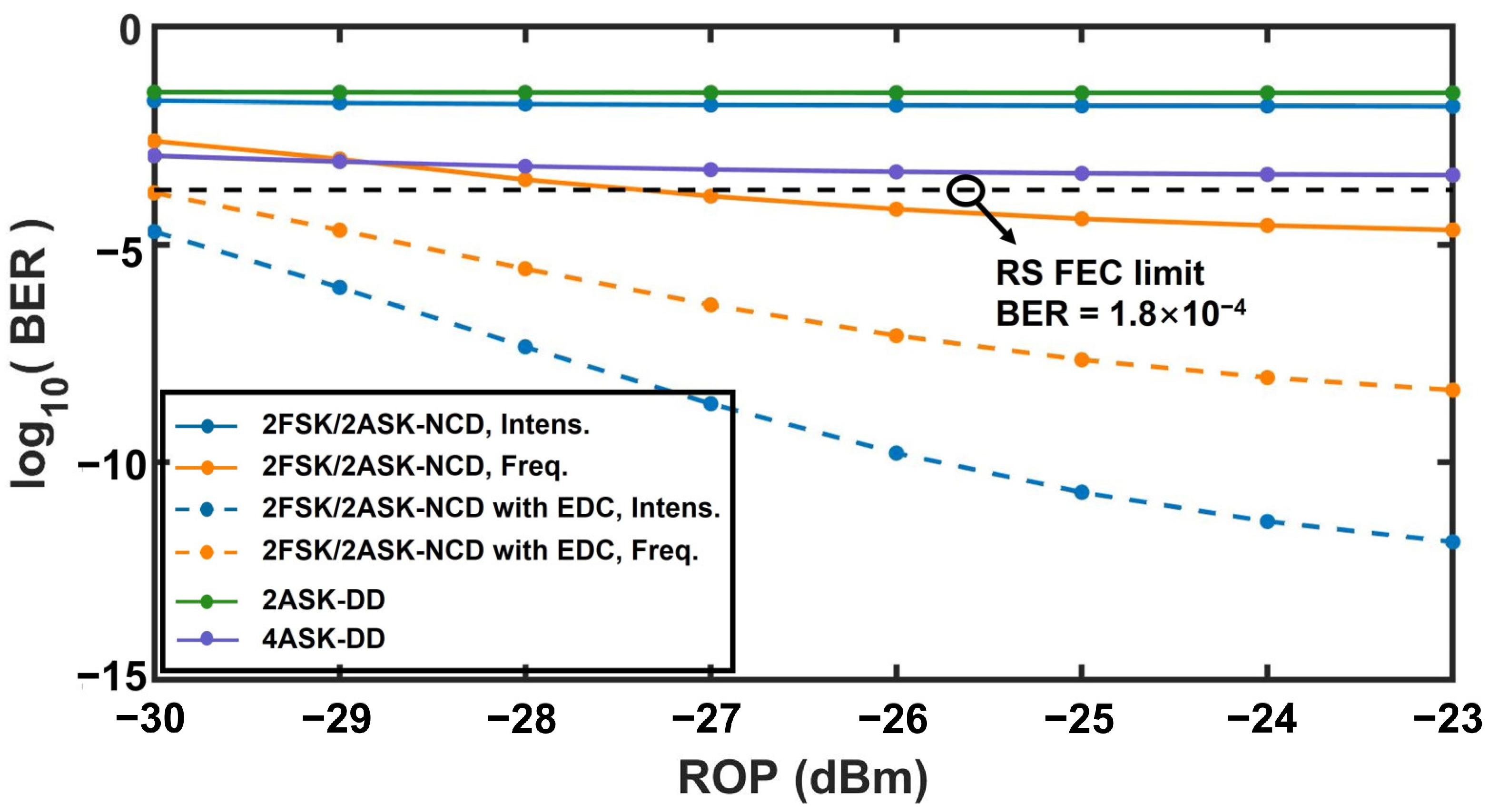

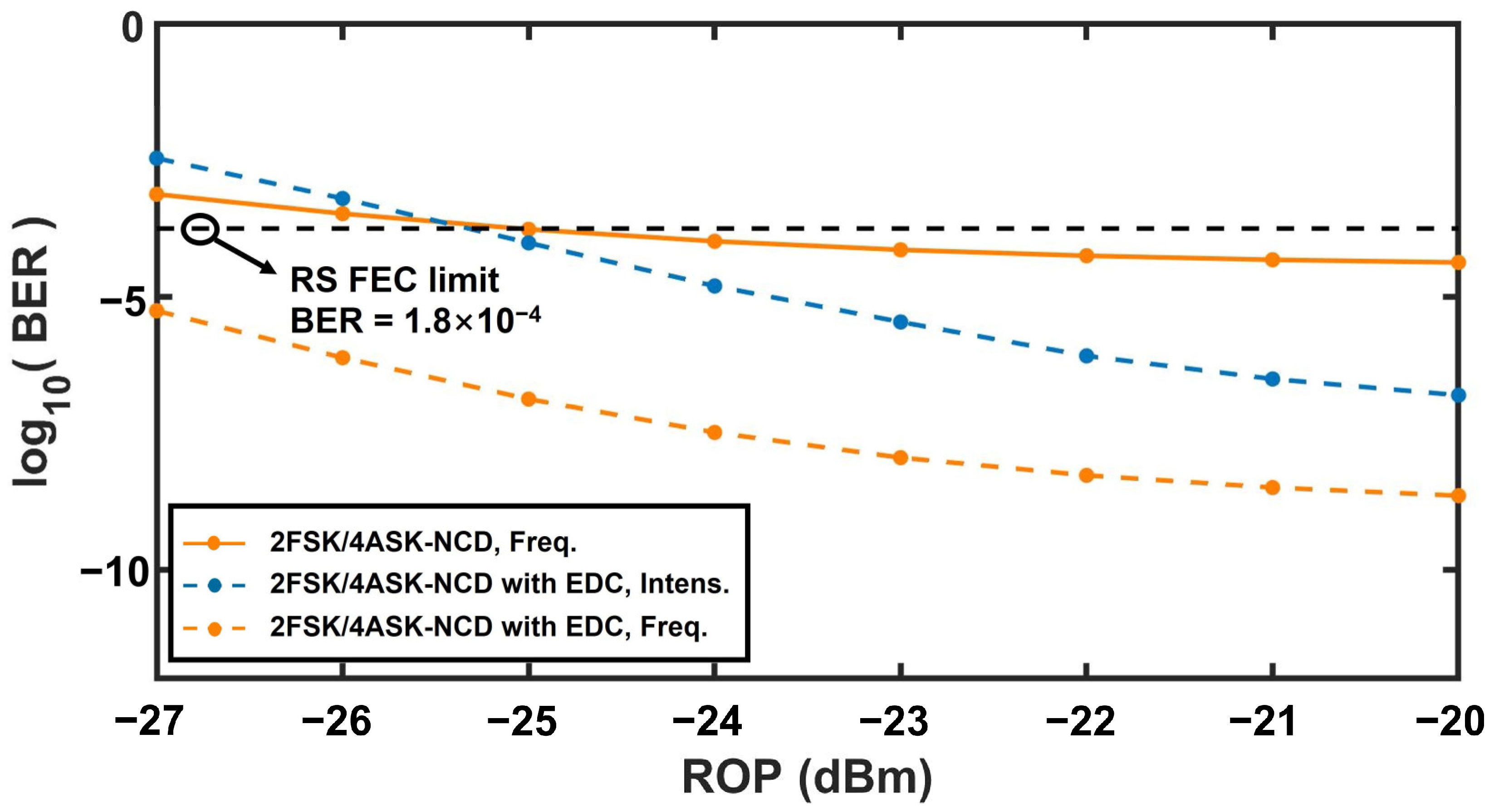
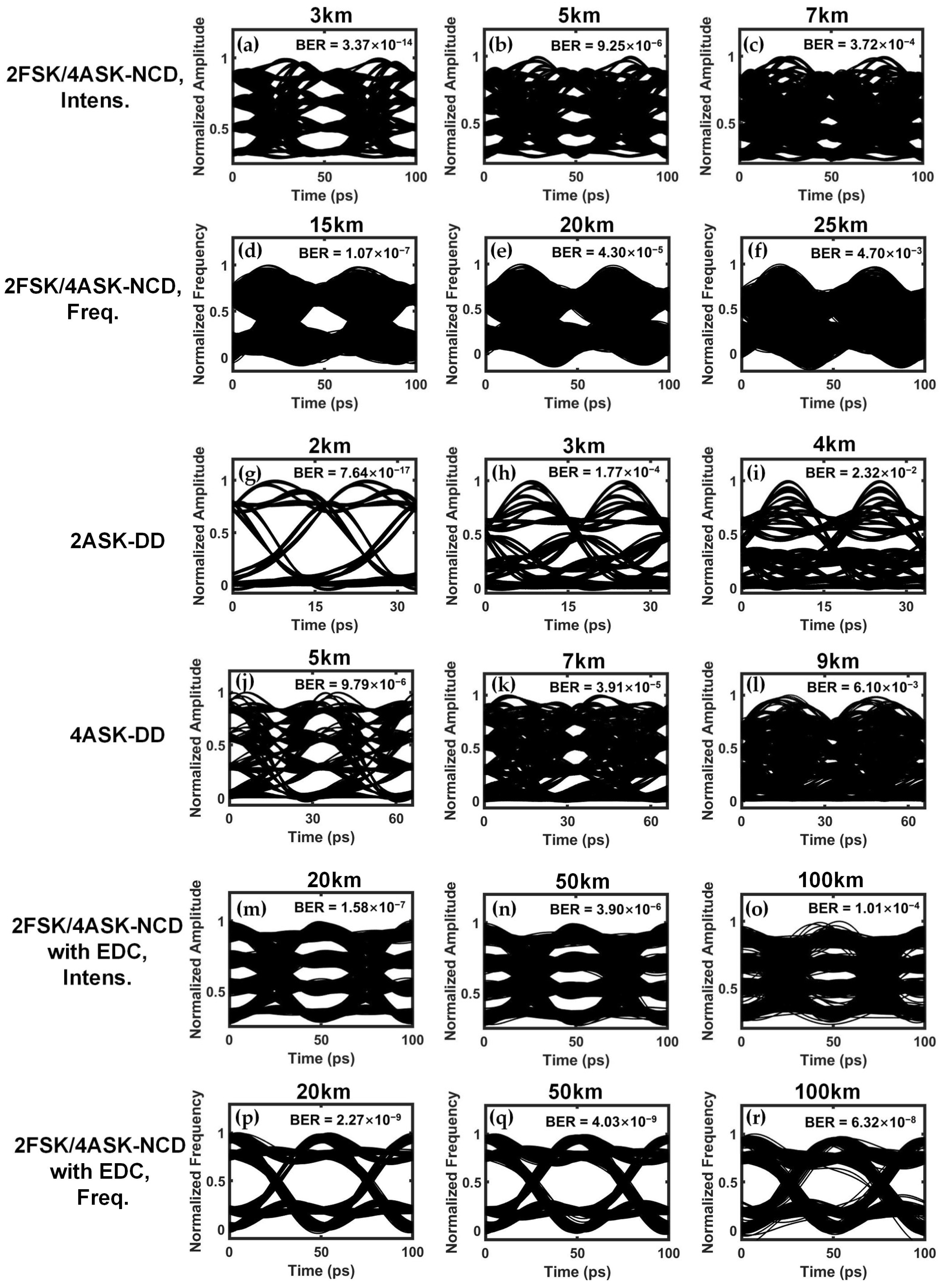
| Parameter | Symbol | Value | Unit |
|---|---|---|---|
| Bragg grating period | 248 | nm | |
| Active region width | 2 | μm | |
| Total quantum well thickness | 0.04 | μm | |
| Active region length | 200 | μm | |
| Optical confinement factor | 0.08 | ||
| Grating coupling coefficient | 75 | cm−1 | |
| Carrier lifetime | 0.1 | ns | |
| Group index | 3.6 | ||
| Material gain coefficient | 2000 | cm−1 | |
| Transparent carrier density | 6 × 1017 | cm−3 | |
| Peak gain wavelength | 1577 | nm | |
| Nonlinear gain suppression coefficient | 6 × 10−17 | cm3 | |
| Optical modal loss | 15 | cm−1 | |
| Reflectivity of front facet | 0.3 | ||
| Reflectivity of back facet | 0.95 | ||
| Effective index without injection | 3.18 | ||
| Spontaneous coupling factor | 1 × 10−4 | ||
| Linewidth enhancement factor | 8 | ||
| IIR filter coefficient | 0.002 |
| Parameter | Symbol | Value | Unit |
|---|---|---|---|
| Active region width | 2 | μm | |
| Total quantum well thickness | 0.04 | μm | |
| Active region length | 200 | μm | |
| Optical confinement factor | 0.08 | ||
| Carrier lifetime | 0.5 * | ns | |
| Group index | 3.6 | ||
| Material gain coefficient | 2000 | cm−1 | |
| Transparent carrier density | 6 × 1017 | cm−3 | |
| Gain profile width | 60 | nm | |
| Peak gain wavelength | 1577 | nm | |
| Nonlinear gain suppression coefficient | 6 × 10−17 | cm3 | |
| Optical modal loss | 15 | cm−1 | |
| Reflectivity of front facet | 0.001 | ||
| Reflectivity of back facet | 0.001 | ||
| Effective index without injection | 3.18 | ||
| Spontaneous coupling factor | 0.01 | ||
| Linewidth enhancement factor | 3 | ||
| Injected current | 100 | mA |
Disclaimer/Publisher’s Note: The statements, opinions and data contained in all publications are solely those of the individual author(s) and contributor(s) and not of MDPI and/or the editor(s). MDPI and/or the editor(s) disclaim responsibility for any injury to people or property resulting from any ideas, methods, instructions or products referred to in the content. |
© 2023 by the authors. Licensee MDPI, Basel, Switzerland. This article is an open access article distributed under the terms and conditions of the Creative Commons Attribution (CC BY) license (https://creativecommons.org/licenses/by/4.0/).
Share and Cite
Xin, L.; Xu, X.; Du, L.; Zhao, J. FSK/ASK Orthogonal Modulation System Based on Novel Noncoherent Detection and Electronic Dispersion Compensation for Short-Reach Optical Communications. Photonics 2024, 11, 44. https://doi.org/10.3390/photonics11010044
Xin L, Xu X, Du L, Zhao J. FSK/ASK Orthogonal Modulation System Based on Novel Noncoherent Detection and Electronic Dispersion Compensation for Short-Reach Optical Communications. Photonics. 2024; 11(1):44. https://doi.org/10.3390/photonics11010044
Chicago/Turabian StyleXin, Lei, Xiao Xu, Liuge Du, and Jia Zhao. 2024. "FSK/ASK Orthogonal Modulation System Based on Novel Noncoherent Detection and Electronic Dispersion Compensation for Short-Reach Optical Communications" Photonics 11, no. 1: 44. https://doi.org/10.3390/photonics11010044
APA StyleXin, L., Xu, X., Du, L., & Zhao, J. (2024). FSK/ASK Orthogonal Modulation System Based on Novel Noncoherent Detection and Electronic Dispersion Compensation for Short-Reach Optical Communications. Photonics, 11(1), 44. https://doi.org/10.3390/photonics11010044




